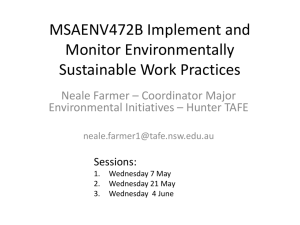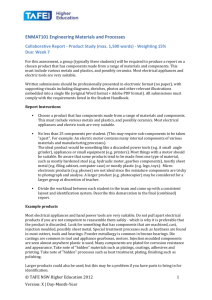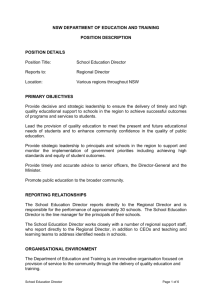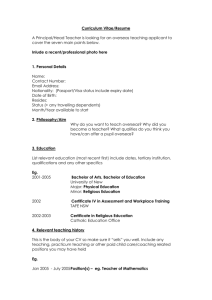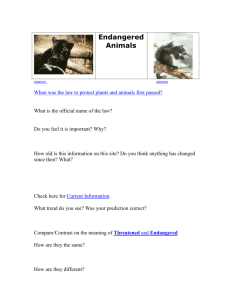MSAENV272B Participate in environmentally sustainable work practices Neale Farmer – Coordinator Major
advertisement
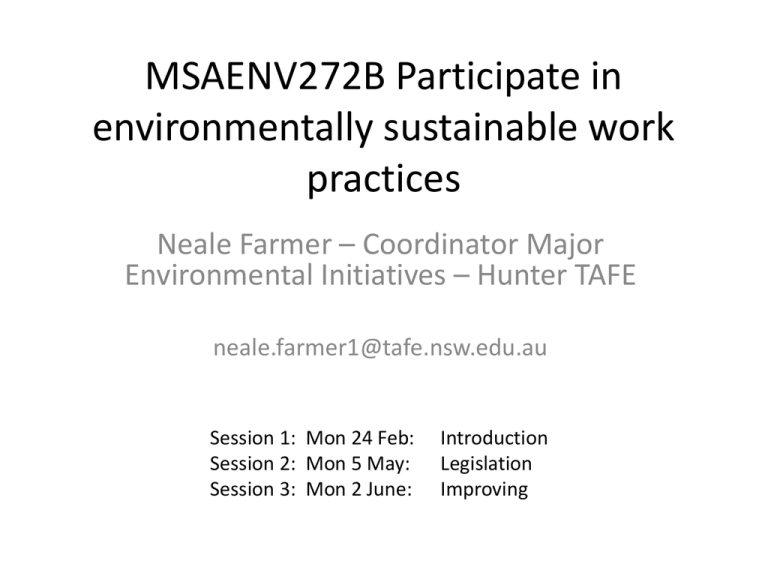
MSAENV272B Participate in environmentally sustainable work practices Neale Farmer – Coordinator Major Environmental Initiatives – Hunter TAFE neale.farmer1@tafe.nsw.edu.au Session 1: Mon 24 Feb: Session 2: Mon 5 May: Session 3: Mon 2 June: Introduction Legislation Improving Recap on last session (24 Feb) - Overview of unit - What is Sustainability? - Exercise on resources, hazards, and performance improvements What sustainability improvements have you made since session 1? Description ………effectively measure current resource use and carry out improvements ………… including those reducing negative environmental impacts of work practices. Application (* place based) – Contextualised!!! ……… applies to operators/team members who are required to follow procedures so as to work in an environmentally sustainable manner. This ensures regulatory compliance and also aims at minimising environmental risks and maximises the environmental performance of the process and the organisation. It includes: Resources used Potential environmental hazards Improving environmental performance (within scope of competency and authority). Hunter TAFE Operations Google: Hunter TAFE http://www.hunter.tafensw.edu.au/About-Us/Pages/Community-and-Industry-Report.aspx Preparation for Session 2 Monday 5 May - Legislation • Visit the NSW Department of Environment and Heritage Website for an overview of relevant environmental legislation: • Download the 2013 Hunter TAFE Strategic Plan to read the Institute’s objectives and targets related to environmental sustainability • View the Session 2 PowerPoint Slides from the Kurri Kurri Campus environmental training Copy of Environmental Compliance Training for Kurri Campus Thursday 17 November 2011 neale.farmer1@tafe.nsw.edu.au karinda.stone@tafe.nsw.edu.au Ext: 53916 Ext: 53174 Overview • • • • • • What? Why? Who? How? When? Where? Preventing pollution, Protecting Biodiversity, Conserving Resources. Cooks River Fishkill, December 2008 http://newslocal.whereiliv e.com.au/news/story/fish -kill-scare/ Dieback infested Banksia woodland Photo: Lorraine Duffy swccnrm.org.au – Protection of the Environment Operations Act 1997 – Pesticides Act 1999 – National Parks and Wildlife Act 1974 – Native Vegetation Act 2003 – Threatened Species Conservation Act 1995 – Radiation Control Act 1990 – Environmental Planning and Assessment Act 1979 – Marine Parks Act 1997 – Environmentally Hazardous Chemicals Act 1985 – Contaminated Land Management Act 1997 – Water Management Act 2000 – Local Government Act 1993 – National Greenhouse and Energy Reporting Act 2007 – Environment Protection and Biodiversity Conservation Act 1999 ACTIVITY 1 Environmental Pollution: What is environmental pollution? Why are we talking about it? Who’s liable, Who’s responsible? Protection of the Environment Operations (POEO) Act 1997 • • • • • Air Noise Water Land Waste Enforcement (Appropriate Regulatory Authority) Environment Protection Authority State and local government organisations including contractors + All premises and activities listed on Schedule 1 POEO Act Local Council Everyone else: Including most smallmedium sized businesses and residential premises Enforcement Environment Protection Authority Licences + Notices + Fines and prosecutions Local Council Notices + Fines and prosecutions Notices Clean Up Administrative fee for issue $320 Monitoring and enforcement costs can be charged Prevention Fines for failure to comply = $750 for individuals, $1500 for corporations (or prosecution) http://www.edo.org.au/edonsw/site/factsh/fs04_1.php Offences • Tier 3 (on the spot fines issues for minor Tier 2 offences) • Tier 2 – strict liability • Tier 1 – willful or negligent Tier 2 Offences Maximum penalties: Individuals = $250,000 (plus $60,000 a day for continuing offences) Corporations = $1million (plus $120,000 per day for continuing offences) Water Land Air Waste Noise Water Pollution 120 Prohibition of pollution of waters (1) A person who pollutes any waters is guilty of an offence. (2) In this section: pollute waters includes cause or permit any waters to be polluted. Which is water pollution? Water Pollution It is not just dangerous chemicals that cause water pollution Even seemingly “safe” substances such as foods, drinks, biodegradable detergents, organic fertilisers can harm the environment Tier 1 Offences • s115 – Disposal of waste to harm the environment • s116 – Leaks, spillages and other escapes • s117 – Emission of ozone depleting substances Willful Negligent Tier 1 Offences Maximum penalties Individual Corporation Negligent $500,000 +/or 4 years gaol $2 million Wilful $1million +/or 7 years gaol $5 million Tier 1 Defence • The offence was due to causes over which the person had no control • The person took reasonable precautions and exercised due diligence to prevent the offence. Duty to notify Notify the appropriate regulatory authority of any pollution incidents causing or threatening material harm to the environment Duty to notify Material harm = 1) actual or potential harm that is not trivial OR 2) Actual or potential loss or property damage amounting to $10,000 Including on your own premises Duty to notify If in doubt call the Office of Environment and Heritage (EPA) 24 hour Pollution Line 131555 Recent Changes • Pollution incidents to be immediately reported, not notified ‘as soon as practicable’; • Establishing the Environmental Protection Authority as an independent, statutory authority headed by a Chief Environmental Regulator. • Double to $2 million the maximum penalty for failing to report an incident immediately; • Clarify the EPA’s powers to conduct mandatory environmental audits. Court decisions • the extent of the harm caused or likely to be caused to the environment • the practical measures that could have been taken to prevent, control, abate or mitigate that harm • the extent to which the person who committed the offence could reasonably have foreseen the harm caused or likely to be caused to the environment Court decisions • the extent to which the person who committed the offence had control over the causes that gave rise to the offence • whether, in committing the offence, the person was complying with orders from an employer or supervising employee. Demonstrate due diligence ACTIVITY 2: What is due diligence? How do WE demonstrate due diligence on this site? How can YOU show due diligence? Environmental improvement plan Site audits Waste disposal receipts Staff training records Due diligence Records of regular inspections and maintenance Environmental Management System Site risk assessment Pollution control equipment and structures Environmental Legal Compliance In NSW…. • Individuals as well as organisations at risk • Fines are very high and gaol terms apply • Local councils are also regulators • Regulators have significant powers • Compliance is outcomes based, not prescribed • Good environmental management required to demonstrate due diligence. Pesticides Act 1995 • • • • ...and Pesticides Regulation 2009 Requirements for record keeping Requirements for training Notification requirements for public authorities • A number of offences see EDO website http://www.edo.org.au/edonsw/site/factsh/fs04_4.php • Pesticide Use Notification Plan (on web) NSW Threatened Species Laws • The Threatened Species Conservation Act 1995: Definitions, listings, declarations, recovery plans, threat abatement plans, licencing, biodiversity certification and biobanking; • The National Parks and Wildlife Act 1974: Additional licencing provisions, provisions for criminal offences; • The Environmental Planning and Assessment Act 1979 Imposes obligations on developers and consent authorities to assess and consider the impacts of development on threatened species All have provision for permits/licences etc. Threatened Species • Presumed extinct • Not recorded in its known or expected habitat within its lifecycle 5 • Critically endangered • Facing an extremely high risk of extinction in NSW in the immediate future 6 • Endangered • Facing a very high risk of extinction in the near future 7 • Vulnerable • Facing a high risk of extinction in the medium-term future 8 Species Populations Communities Ecological Communities: • Critically endangered • Facing an extremely high risk of extinction in the immediate future 13 • Endangered ecological community • Facing a very high risk of extinction in the near future, 14 or • Vulnerable ecological community • Facing a high risk of extinction in the medium-term. 15 Species Populations Communities Endangered Ecological Community Kurri Sand Swamp Woodland in the Sydney Basin Bioregion Image: Stephen Bell Source: DECCW website Kurri Sand Swamp Woodland Spotted Gum Ironbark Community Threats (or risks) The remaining KSSW remnants are threatened by habitat degradation. Some of the main causes of habitat degradation for KSSW include: • Inappropriate fire regimes, particularly frequent fire; • Physical damage and/or erosion from trail bike riding, vehicles, and rubbish dumping; • Changes to drainage conditions and nutrient levels due to clearing of adjacent lands, mowing, slashing and grazing; and • Localised weed invasion. Tools to Protect Threatened Species and Endangered Communities Statutory: • Threatened Species Recovery Plans. Kurri Sand Swamp Woodland (April 2008) Non-Statutory: • • • • Kurri Environmental Management Plan Site Planning Policy and procedures Training and Inductions Induction and training records Site Planning Site audits Due diligence Records of regular inspections and maintenance Environmental Management System Site risk assessment Maintenance procedures / SOP’s ? Other Legislation? Further Information… • Kurri Environmental Management Plan • NSW Environmental Defenders Office: www.edo.org.au/edonsw • OEH: http://www.environment.nsw.gov.au/ • neale.farmer1@tafe.nsw.edu.au Ext: 53916 • karinda.stone@tafe.nsw.edu.au Ext: 53174 Recap – Session 2 • Hunter TAFE Operations • Regulatory Compliance – Due Diligence • Incident Response Resources • http://www.environment.nsw.gov.au/legislati on/ • http://www.edonsw.org.au/ Questions? Next Session (Session 3 - 2 June): Making Improvements Tasks between now and 2 June: - Environmental Compliance - Identify Sustainability Improvements (measure baseline, set target, measure success)
